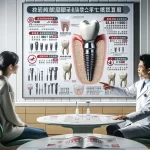In today’s world of dentistry, patients are faced with a multitude of options for restoring their smiles. Among the most prominent choices are composite teeth and dental implants. But how do you determine which solution is right for your unique needs? This comprehensive guide will delve into the benefits, procedures, and innovations surrounding composite teeth and dental implants, equipping you with the knowledge to make an informed decision about your dental health.
Understanding Composite Teeth
What Are Composite Teeth?
Composite teeth, often referred to as composite bonding, involve the application of a tooth-colored resin material designed to repair or enhance the appearance of natural teeth. This versatile procedure can address various dental issues, including:
- Chipped or Cracked Teeth: Restoring structural integrity and aesthetics.
- Discoloration: Improving the appearance of teeth resistant to whitening treatments.
- Gaps Between Teeth: Closing spaces for a more uniform smile.
- Misshapen Teeth: Reshaping for better alignment and appearance.
- Minor Alignment Issues: Correcting slight misalignments without orthodontics.
Types of Composite Materials
Modern dentistry offers several types of composite materials, each tailored for specific needs:
Nanofilled Composites: Known for excellent polish retention and wear resistance, making them suitable for high-stress areas.
Microfilled Composites: Ideal for anterior teeth due to their high shine and aesthetic appeal.
Hybrid Composites: Combining strength and aesthetics, these are versatile enough for various applications.
Benefits of Composite Teeth
Opting for composite bonding comes with numerous advantages:
Cost-Effective: Generally more affordable than other cosmetic dental procedures, making it accessible for many patients.
Minimally Invasive: The procedure preserves more of your natural tooth structure compared to alternatives like crowns or veneers.
Quick Procedure: Often completed in a single visit, allowing for immediate results without extensive downtime.
Versatile Use: Suitable for both cosmetic enhancements and restorative purposes, addressing a wide range of dental concerns.
Natural Appearance: The resin can be matched to your existing tooth color, ensuring a seamless look.
Limitations of Composite Bonding
While composite bonding offers many benefits, it also has some limitations:
Durability: May not be as long-lasting as other restoration options like crowns or dental implants.
Staining Potential: Composite materials can stain over time, particularly with frequent consumption of coffee, tea, or red wine.
Longevity: Typically lasts 5–7 years before requiring replacement or touch-ups.
The Composite Bonding Procedure
The process for composite bonding is straightforward and involves several key steps:
Preparation: The dentist cleans the tooth surface and slightly etches it to ensure better adhesion of the composite material.
Color Matching: A composite resin that closely matches your natural tooth color is selected.
Application: The resin is applied in layers and shaped to achieve the desired form and function.
Curing: A special light is used to harden each layer, ensuring durability.
Polishing: The bonded tooth is polished to match the shine of your natural teeth.
Maintenance and Longevity
To ensure the longevity of your composite bonding:
Practice excellent oral hygiene by brushing twice daily and flossing regularly.
Avoid biting on hard objects or using your teeth as tools to prevent damage.
Limit consumption of staining foods and beverages to maintain appearance.
Schedule regular dental check-ups and cleanings to monitor the condition of the bonding.
With proper care, composite bonding can last between 5 to 7 years before requiring touch-ups or replacement.
Dental Implants: The Gold Standard in Tooth Replacement
What Are Dental Implants?
Dental implants are artificial tooth roots typically made from titanium that are surgically placed into the jawbone to support replacement teeth. They offer a permanent solution for missing teeth and have gained popularity due to their natural look and feel.
Components of a Dental Implant
A dental implant consists of three main components:
Implant: The titanium post that acts as the artificial tooth root.
Abutment: The connector that joins the implant to the crown (the visible part).
Crown: A custom-made prosthetic tooth designed to match your natural teeth in color and shape.
Benefits of Dental Implants
The advantages of dental implants include:
Durability: With proper care, implants can last a lifetime, making them a cost-effective long-term solution for missing teeth.
Natural Appearance and Functionality: They look, feel, and function like natural teeth, providing confidence in your smile.
Bone Preservation: Implants stimulate bone growth in the jaw, preventing bone loss that often occurs with missing teeth.
Improved Oral Health: Unlike bridges, implants do not require altering adjacent teeth, preserving more of your natural dentition.
Versatility: Can replace single teeth, multiple teeth, or support full dentures.
Considerations for Dental Implants
While dental implants offer numerous benefits, there are some considerations:
Higher Initial Cost: Compared to other tooth replacement options like dentures or bridges; however, they may be more cost-effective over time due to their longevity.
Surgical Procedure Required: Involves surgery and a longer treatment timeline than other options; patients should be prepared for multiple appointments over several months.
Not Suitable for Everyone: Patients with insufficient bone density or certain medical conditions may not be candidates for implants.
The Dental Implant Procedure
The process involves several critical steps:
Initial Consultation: Your dentist assesses your oral health and bone density through X-rays or scans.
Treatment Planning: A customized plan is created based on your specific needs; this may include bone grafting if necessary.
Implant Placement Surgery: The titanium post is surgically inserted into the jawbone under local anesthesia.
Osseointegration Phase: A healing period of 3–6 months allows the implant to fuse securely with the bone.
Abutment Placement: Once healed, an abutment is attached to the implant.
Crown Attachment: A custom-made crown is fixed onto the abutment to complete the restoration.
Success Rates and Factors Affecting Outcomes
Recent statistics indicate that dental implants have a success rate of approximately 95%. However, several factors can influence this success:
Smoking
Certain medical conditions (e.g., diabetes)
Poor oral hygiene
Insufficient bone density
Experience level of the implant surgeon
Comparing Composite Teeth and Dental Implants
When considering which option might be best for you, it’s essential to evaluate both composite bonding and dental implants across various factors:
| Factor | Composite Teeth | Dental Implants |
|---|---|---|
| Cost | Lower upfront cost | Higher initial investment |
| Procedure Time | Usually single visit | Several months from start to finish |
| Invasiveness | Minimally invasive | Surgical procedure required |
| Durability | 5–7 years | Can last a lifetime with proper care |
| Maintenance | Regular dental hygiene; potential touch-ups | Regular dental hygiene similar to natural teeth |
| Aesthetic Results | Good but may stain over time | Excellent; closely mimics natural teeth |
| Suitability | Minor cosmetic issues | Missing teeth; major restorations |
Innovations in Dental Technology
Advancements in Composite Materials
The field of composite dentistry continues to evolve with recent innovations such as:
Bioactive Composites: These materials release minerals that help prevent secondary decay while promoting healing in surrounding tissues.
Self-healing Composites: Contain microcapsules that release healing agents when damaged, potentially extending their lifespan significantly.
Color-changing Composites: Indicate when replacement is needed by changing color based on wear or damage.
Cutting-edge Implant Technologies
Dental implant technology is advancing rapidly with developments such as:
3D Printed Implants: Custom-designed implants provide perfect fit and integration into the jawbone while minimizing surgery time.
Nanostructured Implant Surfaces: Enhance osseointegration (the process by which bone fuses with the implant) and reduce healing time significantly.
Zirconia Implants: Metal-free options suitable for patients with metal sensitivities or allergies offer aesthetic advantages without compromising strength.
Future Trends in Dental Restoration
The global market for dental composites is projected to reach USD 140 million by 2036, growing at a compound annual growth rate (CAGR) of 7%. This growth is driven by:
- Increasing demand for cosmetic dentistry
- Growing awareness of oral health
- Technological advancements in dental materials
For dental implants, promising trends include:
- Minimally invasive procedures that reduce recovery time
- Biocompatible materials improving patient outcomes
- Integration with digital dentistry workflows enhancing precision in treatment planning
Choosing the Right Option for You
When deciding between composite bonding and dental implants, consider these factors carefully:
Extent of Damage
- Use composite bonding for minor repairs or aesthetic enhancements; opt for implants if you have missing teeth requiring replacement.
Budget Considerations
- Evaluate both immediate costs (upfront payments) and long-term expenses (maintenance).
Timeline Requirements
- Factor in treatment duration; composite bonding usually requires one visit while implants involve multiple appointments over several months.
Overall Oral Health Condition
- Assess the condition of your jawbone and surrounding teeth; this will influence which option is viable.
Long-term Goals Regarding Aesthetics and Durability
- Consider what you want from your restoration—immediate results vs. long-lasting solutions.
Questions to Ask Your Dentist
When consulting with your dentist about these options, consider asking:
- Which option would you recommend based on my specific case?
- What are the potential risks associated with each procedure?
- How long can I expect my results to last?
- What kind of maintenance will be required after treatment?
- Are there any alternatives I should consider?
Conclusion: Embracing Modern Dental Restoration
Both composite teeth and dental implants offer innovative solutions for restoring your smile effectively. While composite bonding provides a quick and cost-effective option for minor cosmetic issues, dental implants deliver a durable solution for missing teeth that can last a lifetime when cared for properly.
The choice between these two options ultimately depends on individual needs—considering factors such as budget constraints, oral health conditions, and personal preferences regarding aesthetics and functionality.
As advancements in dental technology continue to unfold, exciting developments are anticipated in both fields—making it essential to stay informed about your options. By collaborating closely with your dental professional and understanding each treatment’s nuances, you can make an optimal decision regarding your oral health journey—achieving the smile you’ve always envisioned.
Remember that regardless of which option you choose—composite bonding or dental implants—maintaining good oral hygiene practices along with regular check-ups is crucial for ensuring longevity in any dental work performed.
Disclaimer: This article serves informational purposes only and does not constitute medical advice. Always consult with a qualified dental professional before making decisions regarding your oral health.















